Brain Drain out of the Blue: Pollution-Induced Migration in Vietnam
Abstract
:1. Introduction
2. Materials and Methods
2.1. Model Construction
2.2. Materials
2.3. Methods and Validation
3. Results
3.1. Model 1: Domestic Migration Intention
3.2. Model 2: International Migration Intention
4. Discussion
5. Conclusions
Author Contributions
Funding
Institutional Review Board Statement
Informed Consent Statement
Data Availability Statement
Conflicts of Interest
Appendix A
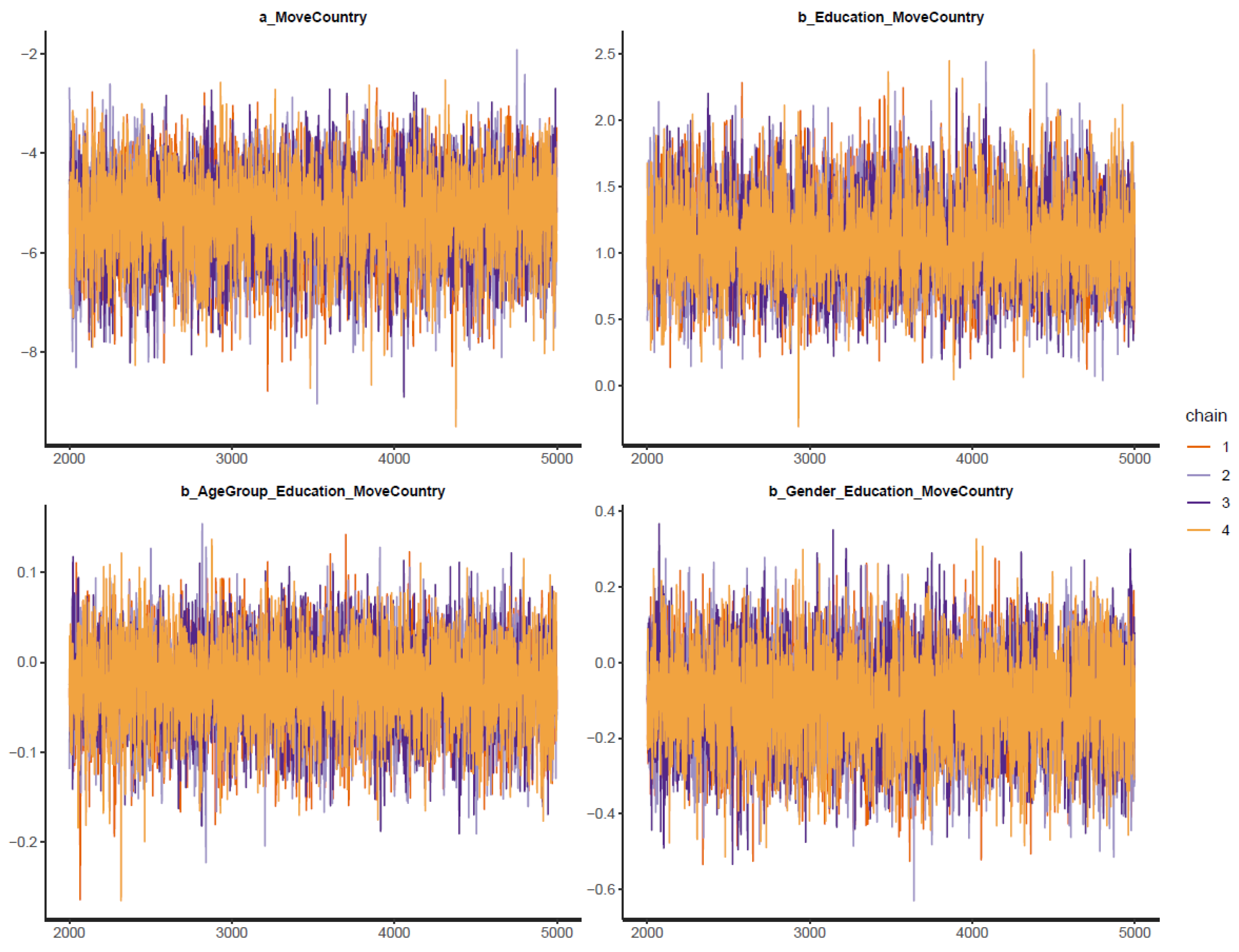

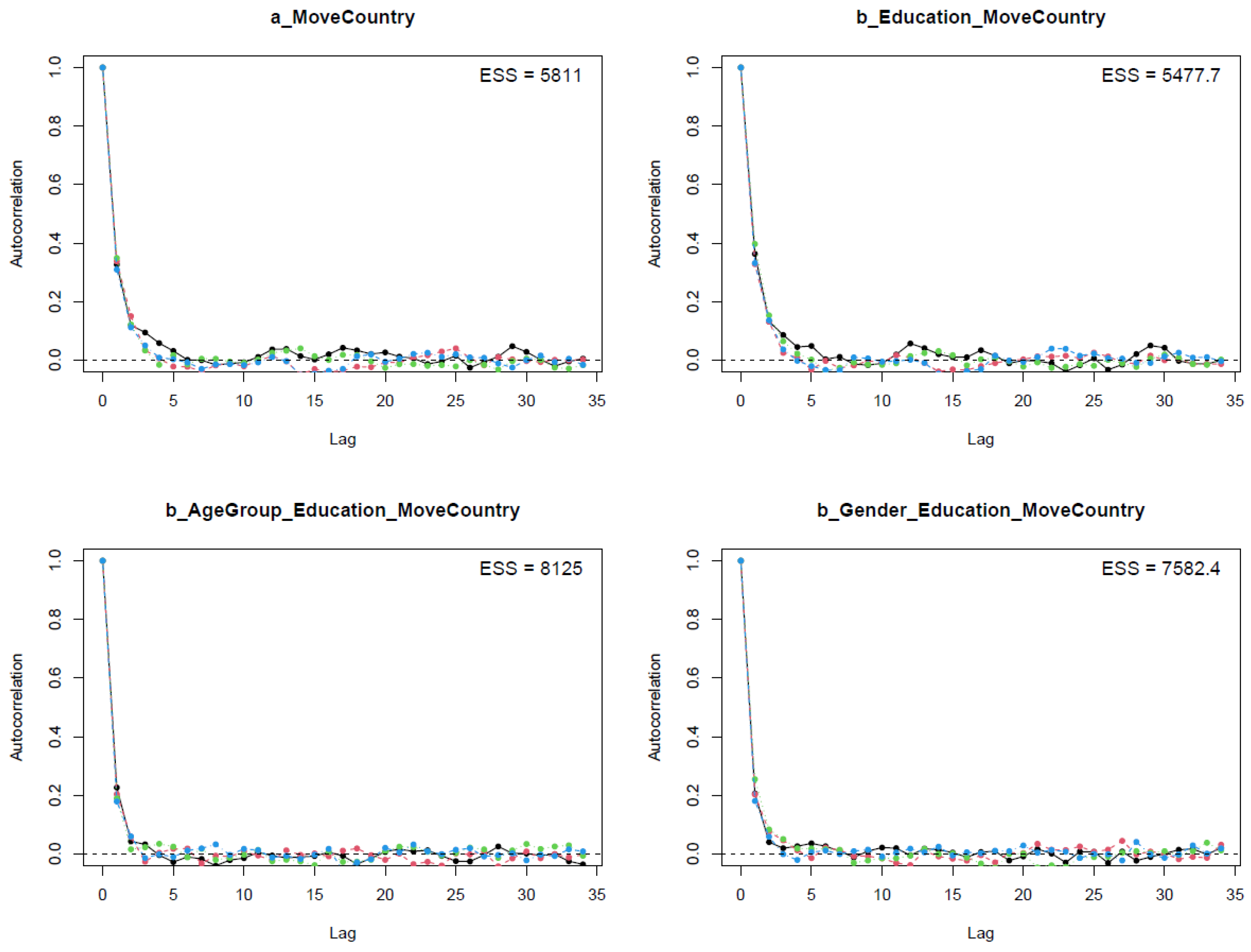
References
- WHO. Air Pollution. Available online: https://www.who.int/health-topics/air-pollution (accessed on 10 February 2022).
- OECD. The Economic Consequences of Outdoor Air Pollution; OECD Publishing: Paris, France, 2016. [Google Scholar]
- Quansah, R.; Semple, S.; Ochieng, C.A.; Juvekar, S.; Armah, F.A.; Luginaah, I.; Emina, J. Effectiveness of interventions to reduce household air pollution and/or improve health in homes using solid fuel in low-and-middle income countries: A systematic review and meta-analysis. Environ. Int. 2017, 103, 73–90. [Google Scholar] [CrossRef] [PubMed] [Green Version]
- Liu, F.; Zhao, Y.; Liu, Y.-Q.; Liu, Y.; Sun, J.; Huang, M.-M.; Liu, Y.; Dong, G.-H. Asthma and asthma related symptoms in 23,326 Chinese children in relation to indoor and outdoor environmental factors: The Seven Northeastern Cities (SNEC) Study. Sci. Total Environ. 2014, 497, 10–17. [Google Scholar] [CrossRef] [PubMed]
- Deng, Q.; Lu, C.; Norbäck, D.; Bornehag, C.-G.; Zhang, Y.; Liu, W.; Yuan, H.; Sundell, J. Early life exposure to ambient air pollution and childhood asthma in China. Environ. Res. 2015, 143, 83–92. [Google Scholar] [CrossRef] [PubMed]
- Amegah, A.K.; Quansah, R.; Jaakkola, J.J. Household air pollution from solid fuel use and risk of adverse pregnancy outcomes: A systematic review and meta-analysis of the empirical evidence. PLoS ONE 2014, 9, e113920. [Google Scholar] [CrossRef]
- Fiordelisi, A.; Piscitelli, P.; Trimarco, B.; Coscioni, E.; Iaccarino, G.; Sorriento, D. The mechanisms of air pollution and particulate matter in cardiovascular diseases. Heart Fail. Rev. 2017, 22, 337–347. [Google Scholar] [CrossRef]
- Guan, W.-J.; Zheng, X.-Y.; Chung, K.F.; Zhong, N.-S. Impact of air pollution on the burden of chronic respiratory diseases in China: Time for urgent action. Lancet 2016, 388, 1939–1951. [Google Scholar] [CrossRef]
- De Marco, A.; Proietti, C.; Anav, A.; Ciancarella, L.; D’Elia, I.; Fares, S.; Fornasier, M.F.; Fusaro, L.; Gualtieri, M.; Manes, F. Impacts of air pollution on human and ecosystem health, and implications for the National Emission Ceilings Directive: Insights from Italy. Environ. Int. 2019, 125, 320–333. [Google Scholar] [CrossRef]
- Cheng, M.-H.; Chen, C.-C.; Chiu, H.-F.; Yang, C.-Y. Fine particulate air pollution and hospital admissions for asthma: A case-crossover study in Taipei. J. Toxicol. Environ. Health Part A 2014, 77, 1075–1083. [Google Scholar] [CrossRef]
- Jiang, X.-Q.; Mei, X.-D.; Feng, D. Air pollution and chronic airway diseases: What should people know and do? J. Thorac. Dis. 2016, 8, E31. [Google Scholar]
- Ancona, C.; Badaloni, C.; Mataloni, F.; Bolignano, A.; Bucci, S.; Cesaroni, G.; Sozzi, R.; Davoli, M.; Forastiere, F. Mortality and morbidity in a population exposed to multiple sources of air pollution: A retrospective cohort study using air dispersion models. Environ. Res. 2015, 137, 467–474. [Google Scholar] [CrossRef] [Green Version]
- Kiesewetter, G.; Schoepp, W.; Heyes, C.; Amann, M. Modelling PM2. 5 impact indicators in Europe: Health effects and legal compliance. Environ. Model. Softw. 2015, 74, 201–211. [Google Scholar] [CrossRef] [Green Version]
- Makri, A.; Stilianakis, N.I. Vulnerability to air pollution health effects. Int. J. Hyg. Environ. Health 2008, 211, 326–336. [Google Scholar] [CrossRef] [PubMed]
- Turner, M.C.; Andersen, Z.J.; Baccarelli, A.; Diver, W.R.; Gapstur, S.M.; Pope III, C.A.; Prada, D.; Samet, J.; Thurston, G.; Cohen, A. Outdoor air pollution and cancer: An overview of the current evidence and public health recommendations. CA Cancer J. Clin. 2020, 70, 460–479. [Google Scholar] [CrossRef] [PubMed]
- Buoli, M.; Grassi, S.; Caldiroli, A.; Carnevali, G.S.; Mucci, F.; Iodice, S.; Cantone, L.; Pergoli, L.; Bollati, V. Is there a link between air pollution and mental disorders? Environ. Int. 2018, 118, 154–168. [Google Scholar] [CrossRef]
- Zhang, X.; Chen, X.; Zhang, X. The impact of exposure to air pollution on cognitive performance. Proc. Natl. Acad. Sci. USA 2018, 115, 9193–9197. [Google Scholar] [CrossRef] [Green Version]
- Tallon, L.A.; Manjourides, J.; Pun, V.C.; Salhi, C.; Suh, H. Cognitive impacts of ambient air pollution in the National Social Health and Aging Project (NSHAP) cohort. Environ. Int. 2017, 104, 102–109. [Google Scholar] [CrossRef]
- Gu, H.; Yan, W.; Elahi, E.; Cao, Y. Air pollution risks human mental health: An implication of two-stages least squares estimation of interaction effects. Environ. Sci. Pollut. Res. 2020, 27, 2036–2043. [Google Scholar] [CrossRef]
- Sass, V.; Kravitz-Wirtz, N.; Karceski, S.M.; Hajat, A.; Crowder, K.; Takeuchi, D. The effects of air pollution on individual psychological distress. Health Place 2017, 48, 72–79. [Google Scholar] [CrossRef]
- Casas, L.; Cox, B.; Bauwelinck, M.; Nemery, B.; Deboosere, P.; Nawrot, T.S. Does air pollution trigger suicide? A case-crossover analysis of suicide deaths over the life span. Eur. J. Epidemiol. 2017, 32, 973–981. [Google Scholar] [CrossRef]
- Kim, Y.; Ng, C.F.S.; Chung, Y.; Kim, H.; Honda, Y.; Guo, Y.L.; Lim, Y.-H.; Chen, B.-Y.; Page, L.A.; Hashizume, M. Air Pollution and Suicide in 10 Cities in Northeast Asia: A Time-Stratified Case-Crossover Analysis. Environ. Health Perspect. 2018, 126, 037002. [Google Scholar] [CrossRef] [Green Version]
- Mohai, P.; Kweon, B.-S.; Lee, S.; Ard, K. Air Pollution Around Schools Is Linked To Poorer Student Health And Academic Performance. Health Aff. 2011, 30, 852–862. [Google Scholar] [CrossRef] [PubMed] [Green Version]
- Delgado-Saborit, J.M.; Guercio, V.; Gowers, A.M.; Shaddick, G.; Fox, N.C.; Love, S. A critical review of the epidemiological evidence of effects of air pollution on dementia, cognitive function and cognitive decline in adult population. Sci. Total Environ. 2021, 757, 143734. [Google Scholar] [CrossRef] [PubMed]
- Gatto, N.M.; Henderson, V.W.; Hodis, H.N.; John, J.A.S.; Lurmann, F.; Chen, J.-C.; Mack, W.J. Components of air pollution and cognitive function in middle-aged and older adults in Los Angeles. Neurotoxicology 2014, 40, 1–7. [Google Scholar] [CrossRef] [PubMed] [Green Version]
- Oudin, A.; Forsberg, B.; Adolfsson, A.N.; Lind, N.; Modig, L.; Nordin, M.; Nordin, S.; Adolfsson, R.; Nilsson, L.-G. Traffic-Related Air Pollution and Dementia Incidence in Northern Sweden: A Longitudinal Study. Environ. Health Perspect. 2016, 124, 306–312. [Google Scholar] [CrossRef]
- Xu, X.; Wang, Q.; Hu, H.; Wang, X. Air pollution control: An analysis of China’s industrial off-peak production policy through the Quasi-natural experiment method. Sustainability 2021, 13, 4808. [Google Scholar] [CrossRef]
- Bagayev, I.; Lochard, J. EU air pollution regulation: A breath of fresh air for Eastern European polluting industries? J. Environ. Econ. Manag. 2017, 83, 145–163. [Google Scholar] [CrossRef]
- Turnock, S.; Butt, E.; Richardson, T.; Mann, G.; Reddington, C.; Forster, P.; Haywood, J.; Crippa, M.; Janssens-Maenhout, G.; Johnson, C. The impact of European legislative and technology measures to reduce air pollutants on air quality, human health and climate. Environ. Res. Lett. 2016, 11, 024010. [Google Scholar] [CrossRef] [Green Version]
- Kuklinska, K.; Wolska, L.; Namiesnik, J. Air quality policy in the US and the EU—A review. Atmos. Pollut. Res. 2015, 6, 129–137. [Google Scholar] [CrossRef]
- Hao, Y.; Deng, Y.; Lu, Z.-N.; Chen, H. Is environmental regulation effective in China? Evidence from city-level panel data. J. Clean. Prod. 2018, 188, 966–976. [Google Scholar] [CrossRef]
- Yang, W.; Yuan, G.; Han, J. Is China’s air pollution control policy effective? Evidence from Yangtze River Delta cities. J. Clean. Prod. 2019, 220, 110–133. [Google Scholar] [CrossRef]
- Zhang, J.; Mu, Q. Air pollution and defensive expenditures: Evidence from particulate-filtering facemasks. J. Environ. Econ. Manag. 2018, 92, 517–536. [Google Scholar] [CrossRef]
- Chen, S.; Chen, Y.; Lei, Z.; Tan-Soo, J.-S. Chasing clean air: Pollution-induced travels in China. J. Assoc. Environ. Resour. Econ. 2021, 8, 59–89. [Google Scholar] [CrossRef]
- Yu, H.; Cheng, J.; Gordon, S.P.; An, R.; Yu, M.; Chen, X.; Yue, Q.; Qiu, J. Impact of air pollution on sedentary behavior: A cohort study of freshmen at a university in Beijing, China. Int. J. Environ. Res. Public Health 2018, 15, 2811. [Google Scholar] [CrossRef] [PubMed] [Green Version]
- An, R.; Zhang, S.; Ji, M.; Guan, C. Impact of ambient air pollution on physical activity among adults: A systematic review and meta-analysis. Perspect. Public Health 2018, 138, 111–121. [Google Scholar] [CrossRef] [PubMed]
- Vega-Muñoz, A.; Gónzalez-Gómez-del-Miño, P.; Espinosa-Cristia, J.F. Recognizing new trends in brain drain studies in the framework of global sustainability. Sustainability 2021, 13, 3195. [Google Scholar] [CrossRef]
- The Fragile States Index Team. Fragile States Index 2021—Annual Report; The Fund for Peace: Washington, DC, USA, 2022. [Google Scholar]
- Docquier, F.; Peri, G.; Ruyssen, I. The Cross-country Determinants of Potential and Actual Migration. Int. Migr. Rev. 2014, 48, 37–99. [Google Scholar] [CrossRef] [Green Version]
- Dao, T.H.; Docquier, F.; Parsons, C.; Peri, G. Migration and development: Dissecting the anatomy of the mobility transition. J. Dev. Econ. 2018, 132, 88–101. [Google Scholar] [CrossRef] [Green Version]
- Telli, H. Less poverty, more emigration: Understanding migrant flows from developing countries. Migr. Dev. 2014, 3, 54–72. [Google Scholar] [CrossRef]
- Clemens, M.A. Does development reduce migration? In International Handbook on Migration and Economic Development; Lucas, R.E.B., Ed.; Edward Elgar Publishing: Cheltenham, UK, 2014. [Google Scholar]
- Idu, R. Source country economic development and dynamics of the skill composition of emigration. Economies 2019, 7, 18. [Google Scholar] [CrossRef] [Green Version]
- Campos, R.G. International migration pressures in the long run. SSRN 2017, 1734, 35. [Google Scholar] [CrossRef]
- United Nations. World Migration Report 2020; International Organization for Migration: Grand-Saconnex, Switzerland, 2020. [Google Scholar]
- Vuong, Q.-H.; Le, T.-T.; Nguyen, Q.-L.; Nguyen, Q.-T.; Nguyen, M.-H. Escaping from air pollution: The psychological process of domestic migration intention among urban people. Arxiv 2021, arXiv:2108.00497. [Google Scholar]
- Nguyen, M.-H.; Le, T.-T.; Khuc, Q. Bayesian Mindsponge Framework. Scholarly Community Encyclopedia. 2021. Available online: https://encyclopedia.pub/13852 (accessed on 25 January 2022).
- Nguyen, M.-H.; Le, T.-T.; Nguyen, H.-K.T.; Ho, M.-T.; Nguyen, H.T.T.; Vuong, Q.-H. Alice in Suicideland: Exploring the Suicidal Ideation Mechanism through the Sense of Connectedness and Help-Seeking Behaviors. Int. J. Environ. Res. Public Health 2021, 18, 3681. [Google Scholar] [CrossRef] [PubMed]
- Vuong, Q.-H.; Napier, N.K. Acculturation and global mindsponge: An emerging market perspective. Int. J. Intercult. Relat. 2015, 49, 354–367. [Google Scholar] [CrossRef]
- Vuong, Q.H. Global Mindset as the Integration of Emerging Socio-Cultural Values Through Mindsponge Processes: A Transition Economy Perspective. In Global Mindsets: Exploration and Perspectives; Kuada, J., Ed.; Routledge: London, UK, 2016; pp. 109–126. [Google Scholar]
- Vuong, Q.-H.; Le, T.-T.; Nguyen, Q.-L.; Nguyen, M.-H. Investigation into the rationale of migration intention due to air pollution integrating the Homo Oeconomicus traits. OSF Prepr. 2021. [Google Scholar] [CrossRef]
- Vuong, Q.-H.; Le, T.-T.; La, V.-P.; Nguyen, T.T.H.; Ho, M.-T.; Khuc, Q.; Nguyen, M.-H. Covid-19 vaccines production and societal immunization under the serendipity-mindsponge-3D knowledge management theory and conceptual framework. Humanit. Soc. Sci. Commun. 2022, 9, 22. [Google Scholar] [CrossRef]
- Khuc, V.Q.; Phu, T.V.; Luu, P. Dataset on the Hanoian suburbanites’ perception and mitigation strategies towards air pollution. Data Brief 2020, 33, 106414. [Google Scholar] [CrossRef]
- Vuong, Q.-H.; Phu, T.V.; Le, T.-A.T.; Van Khuc, Q. Exploring Inner-City Residents’ and Foreigners’ Commitment to Improving Air Pollution: Evidence from a Field Survey in Hanoi, Vietnam. Data 2021, 6, 39. [Google Scholar] [CrossRef]
- Kerkhoff, D.; Nussbeck, F.W. The influence of sample size on parameter estimates in three-level random-effects models. Front. Psychol. 2019, 10, 1067. [Google Scholar] [CrossRef] [Green Version]
- Baker, M. Over half of psychology studies fail reproducibility test. Nature 2015. [Google Scholar] [CrossRef]
- Camerer, C.F.; Dreber, A.; Holzmeister, F.; Ho, T.-H.; Huber, J.; Johannesson, M.; Kirchler, M.; Nave, G.; Nosek, B.A.; Pfeiffer, T. Evaluating the replicability of social science experiments in Nature and Science between 2010 and 2015. Nat. Hum. Behav. 2018, 2, 637–644. [Google Scholar] [CrossRef] [Green Version]
- Halsey, L.G.; Curran-Everett, D.; Vowler, S.L.; Drummond, G.B. The fickle P value generates irreproducible results. Nat. Methods 2015, 12, 179–185. [Google Scholar] [CrossRef] [PubMed]
- Dunson, D.B. Commentary: Practical advantages of Bayesian analysis of epidemiologic data. Am. J. Epidemiol. 2001, 153, 1222–1226. [Google Scholar] [CrossRef] [PubMed] [Green Version]
- Hahn, E.D.; Doh, J.P. Using Bayesian methods in strategy research: An extension of Hansenetal. Strateg. Manag. J. 2006, 27, 783–798. [Google Scholar] [CrossRef]
- Vehtari, A.; Gelman, A.; Gabry, J. Practical Bayesian model evaluation using leave-one-out cross-validation and WAIC. Stat. Comput. 2017, 27, 1413–1432. [Google Scholar] [CrossRef] [Green Version]
- Vuong, Q.-H.; La, V.-P.; Nguyen, M.-H.; Ho, M.-T.; Tran, T.; Ho, M.-T. Bayesian analysis for social data: A step-by-step protocol and interpretation. MethodsX 2020, 7, 100924. [Google Scholar] [CrossRef] [PubMed]
- Vuong, Q.-H. The (ir)rational consideration of the cost of science in transition economies. Nat. Hum. Behav. 2018, 2, 5. [Google Scholar] [CrossRef]
- Vuong, Q.-H. Reform retractions to make them more transparent. Nature 2020, 582, 149. [Google Scholar] [CrossRef]
- Miller, E. A note on the role of distance in migration: Costs of mobility versus intervening opportunities. J. Reg. Sci. 1972, 12, 475–478. [Google Scholar] [CrossRef]
- Ward, C.; Bochner, S.; Furnham, A. The Psychology of Culture Shock, 2nd ed.; Routledge: London, UK, 2020. [Google Scholar]
- Knodel, J.; Loi, V.M.; Jayakody, R.; Huy, V.T. Gender roles in the family: Change and stability in Vietnam. Asian Popul. Stud. 2005, 1, 69–92. [Google Scholar] [CrossRef]
- Vuong, Q.-H.; Bui, Q.-K.; La, V.-P.; Vuong, T.-T.; Nguyen, V.-H.T.; Ho, M.-T.; Nguyen, H.-K.T.; Ho, M.-T. Cultural additivity: Behavioural insights from the interaction of Confucianism, Buddhism and Taoism in folktales. Palgrave Commun. 2018, 4, 143. [Google Scholar] [CrossRef] [Green Version]
- Chindarkar, N. Is Subjective Well-Being of Concern to Potential Migrants from Latin America? Soc. Indic. Res. 2014, 115, 159–182. [Google Scholar] [CrossRef]
- Lai, W.; Song, H.; Wang, C.; Wang, H. Air pollution and brain drain: Evidence from college graduates in China. China Econ. Rev. 2021, 68, 101624. [Google Scholar] [CrossRef]
- Lu, H.; Yue, A.; Chen, H.; Long, R. Could smog pollution lead to the migration of local skilled workers? Evidence from the Jing-Jin-Ji region in China. Resour. Conserv. Recycl. 2018, 130, 177–187. [Google Scholar] [CrossRef]
- Xu, X.; Sylwester, K. Environmental Quality and International Migration: Environmental Quality and International Migration. Kyklos 2016, 69, 157–180. [Google Scholar] [CrossRef]
- Xue, S.; Zhang, B.; Zhao, X. Brain Drain: The Impact of Air Pollution on Firm Performance. SSRN Electron. J. 2019. [Google Scholar] [CrossRef]
- Vuong, Q.-H. The semiconducting principle of monetary and environmental values exchange. Econ. Bus. Lett. 2021, 10, 284–290. [Google Scholar] [CrossRef]
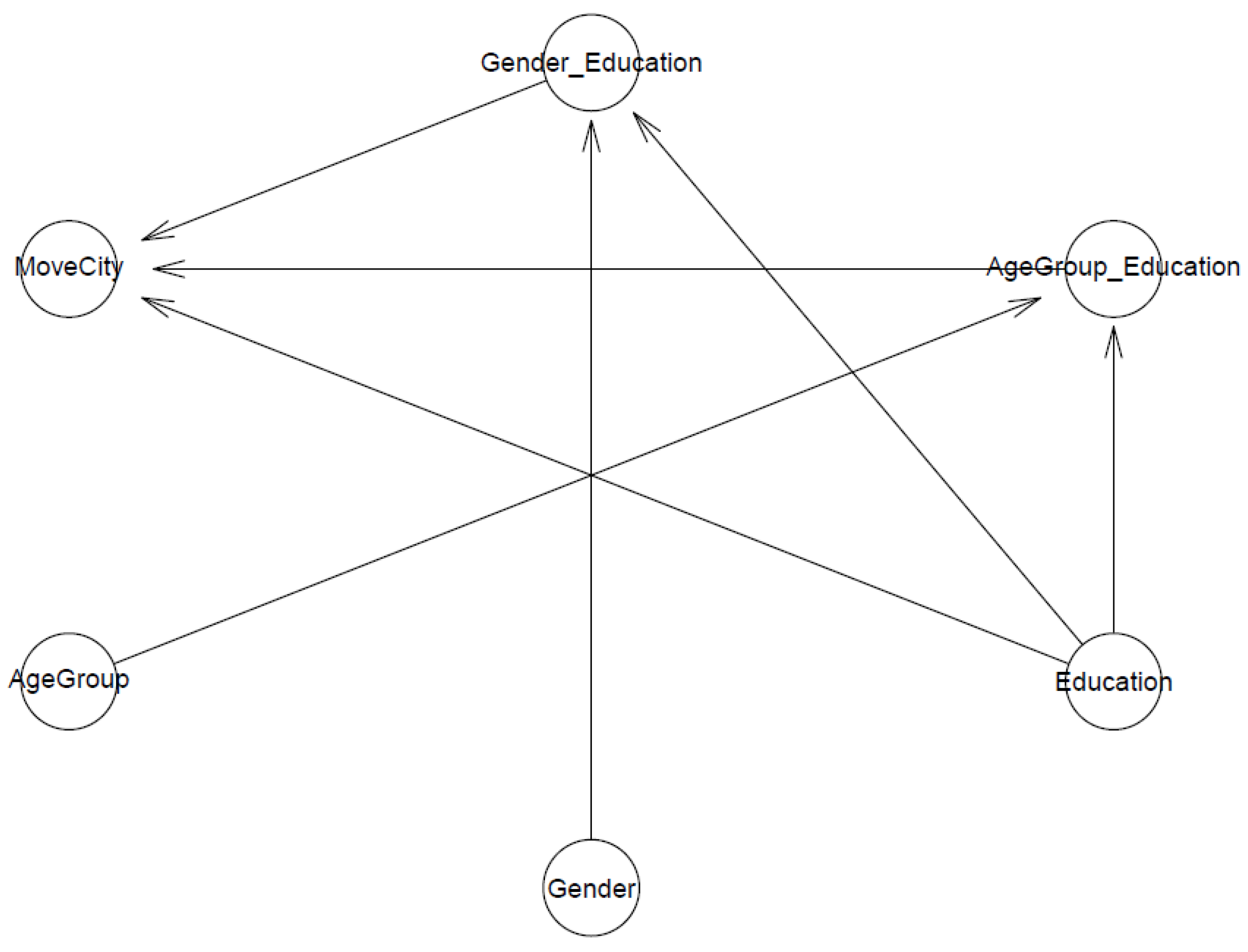
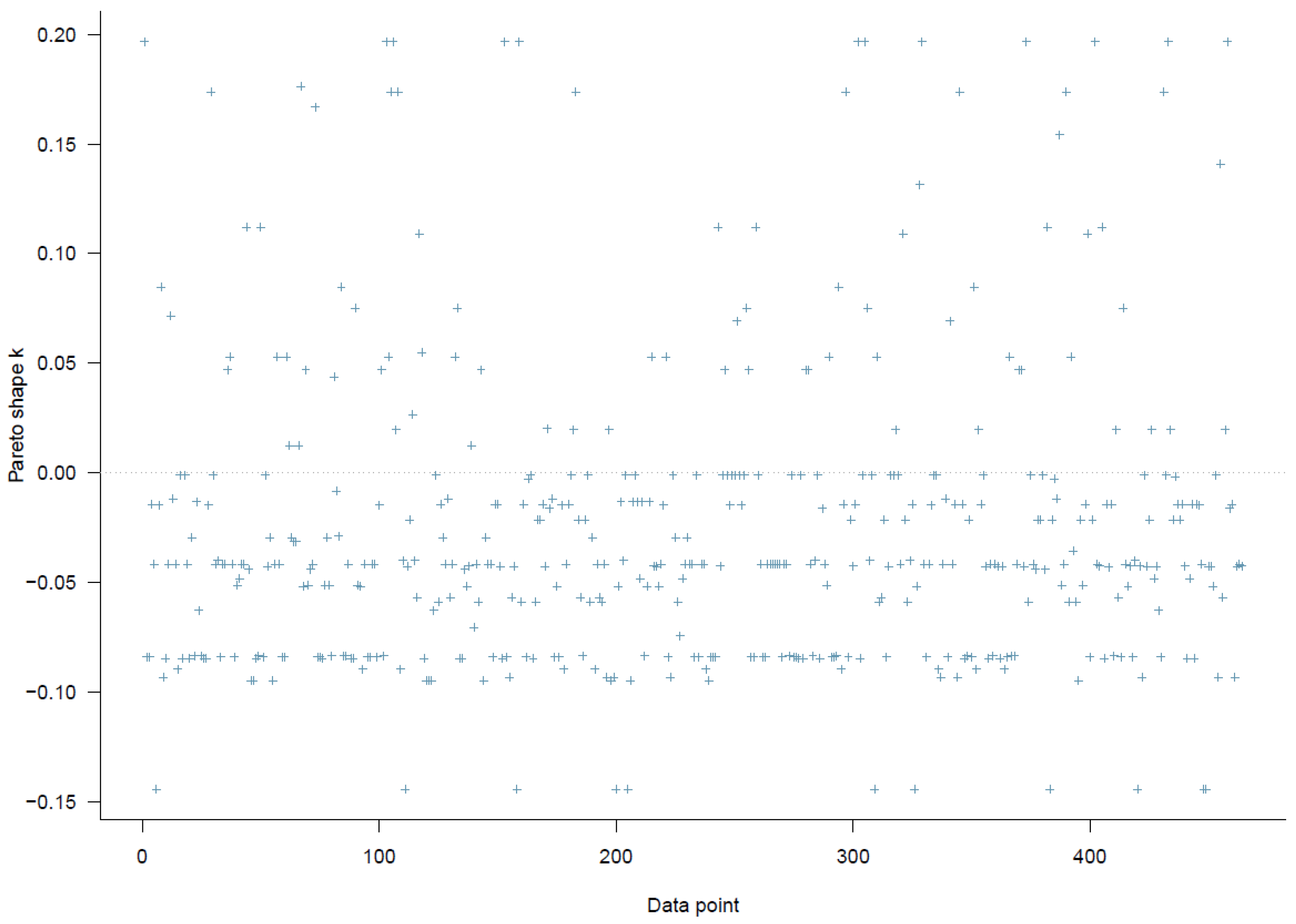
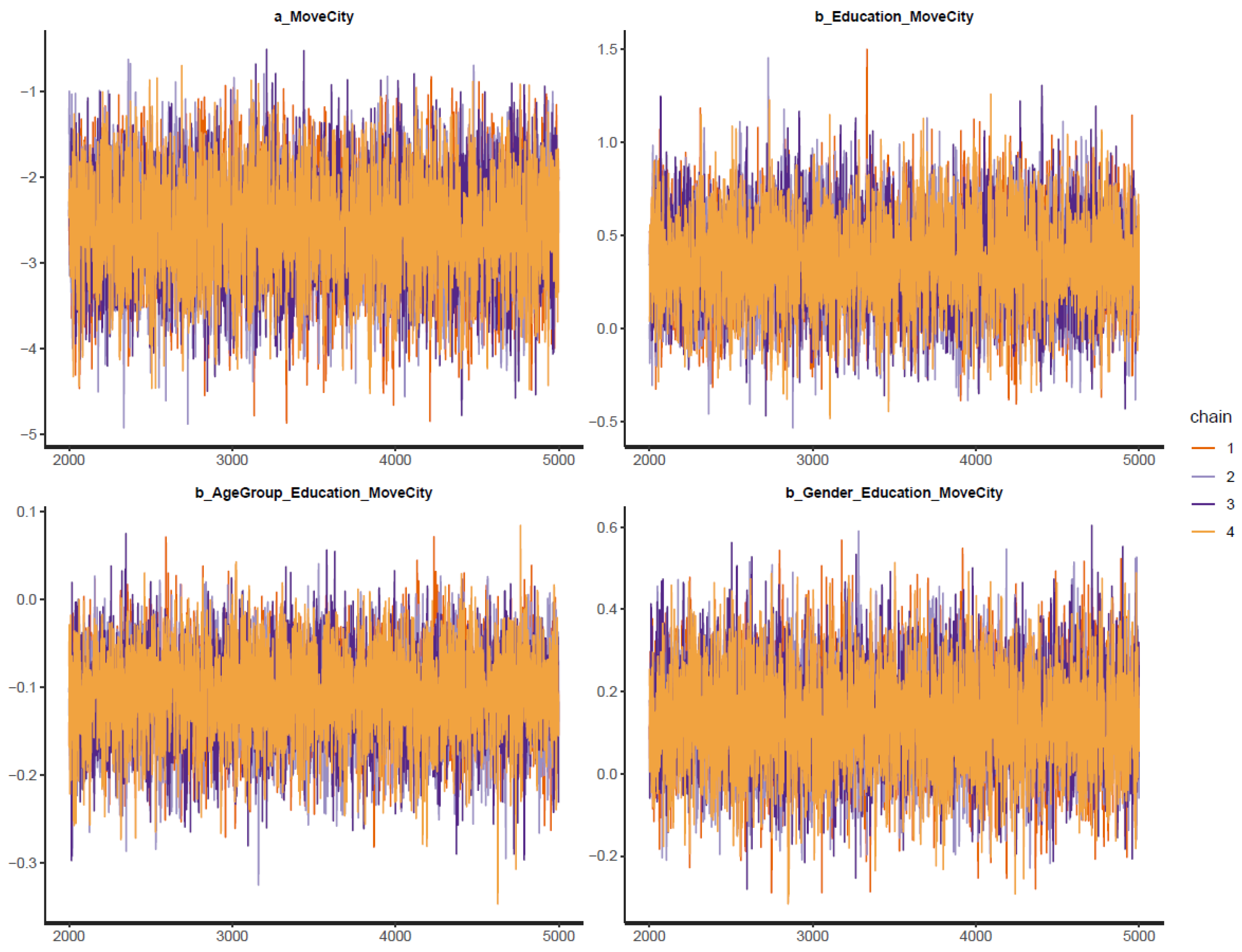
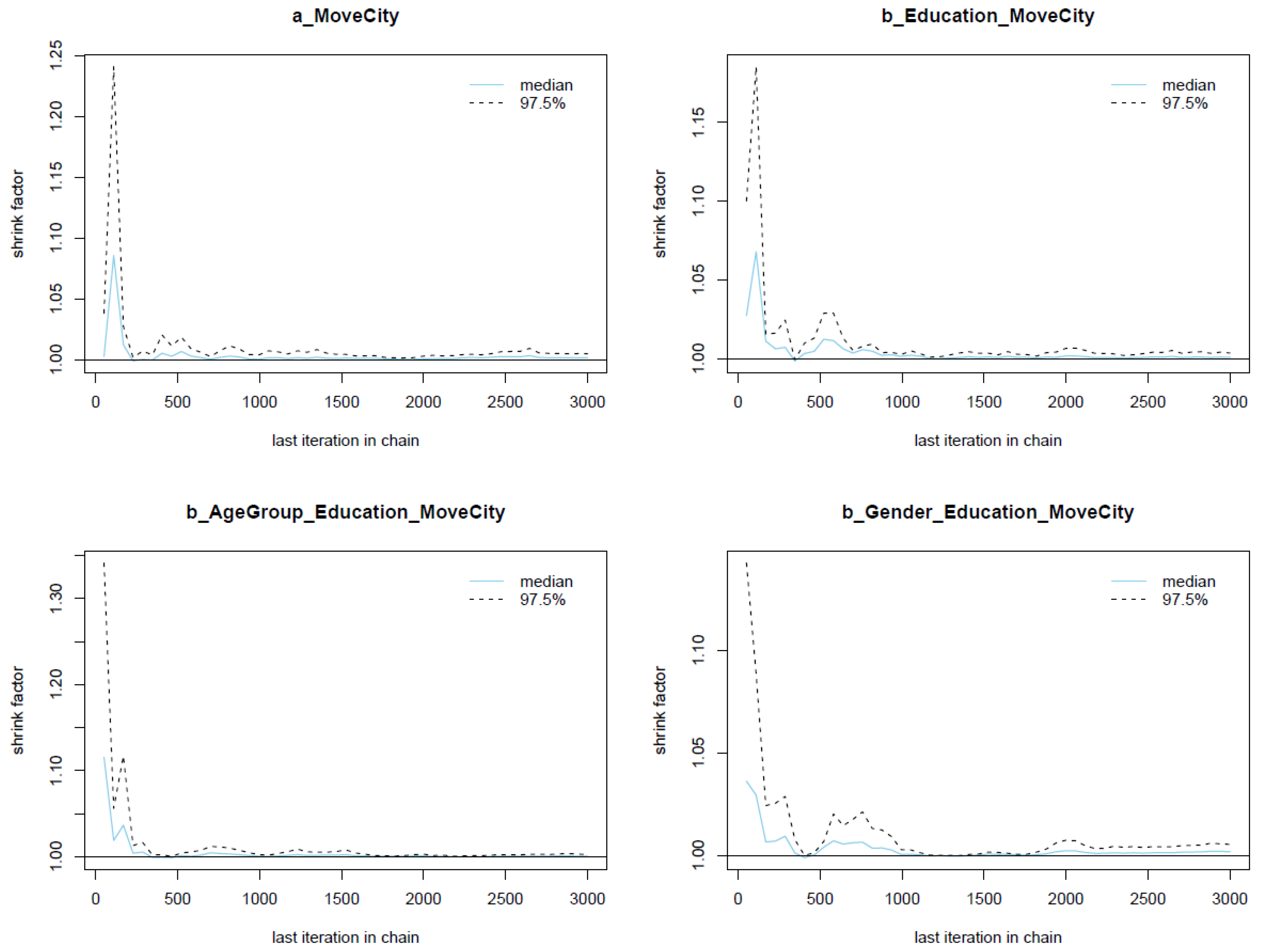
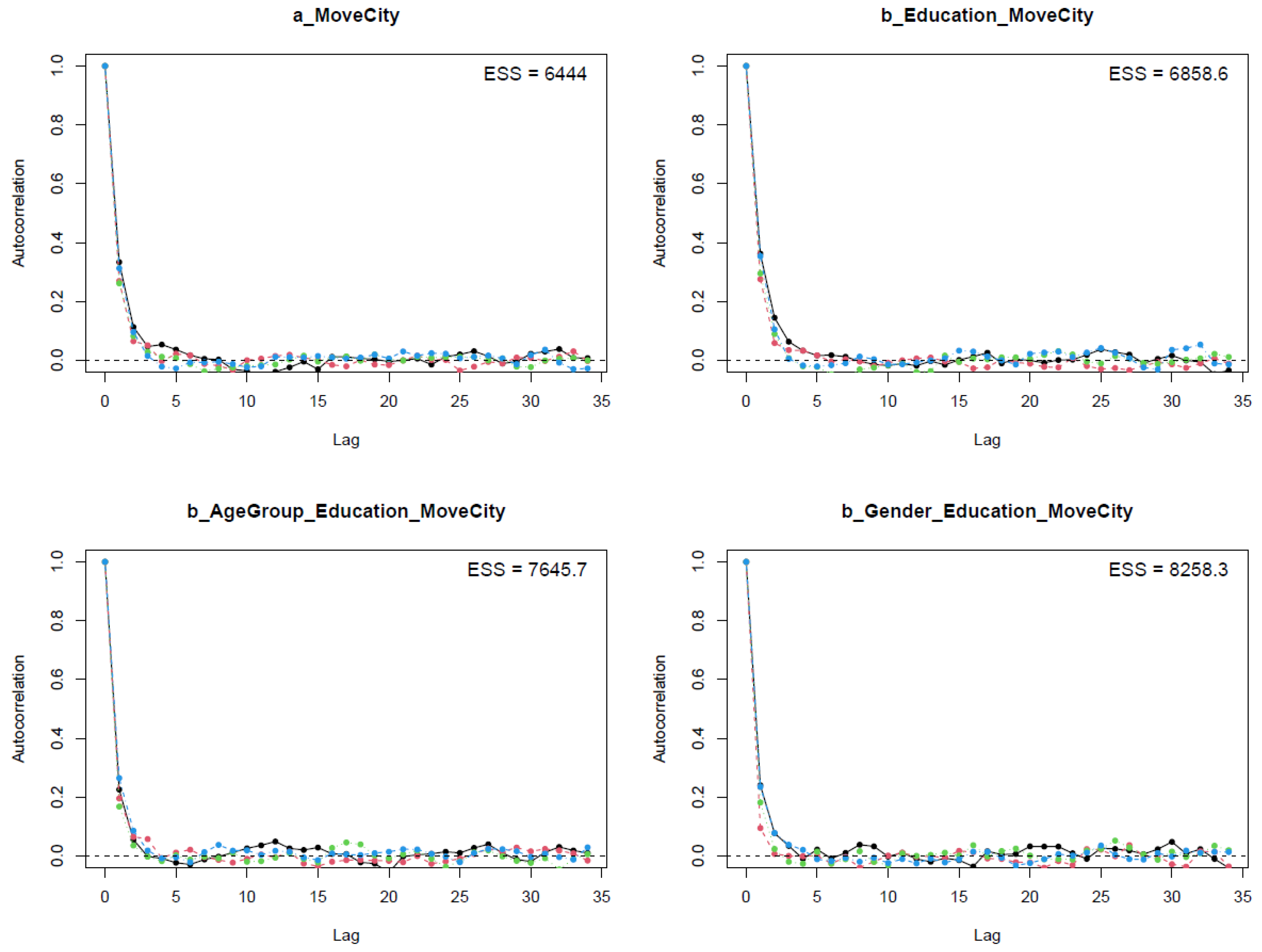
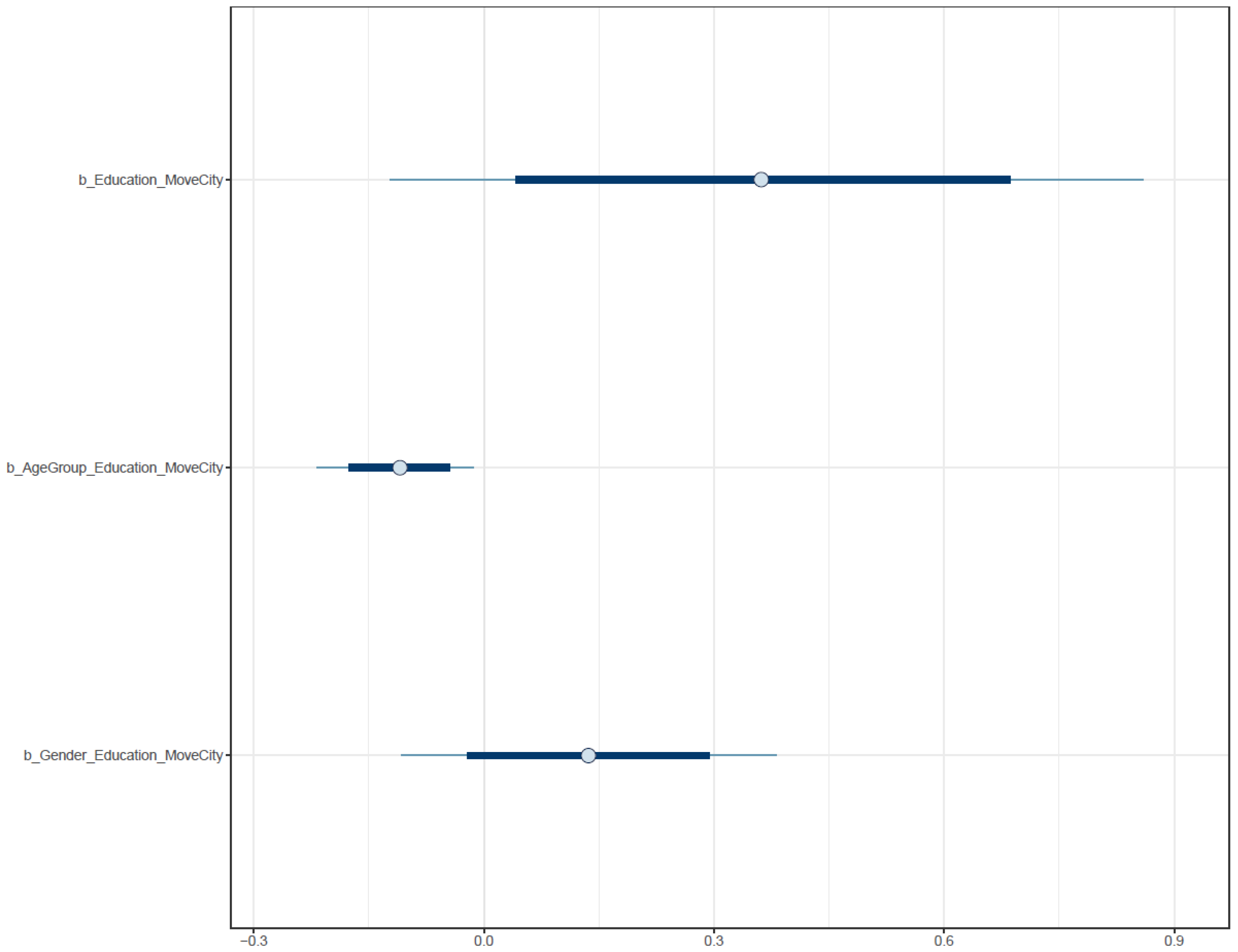
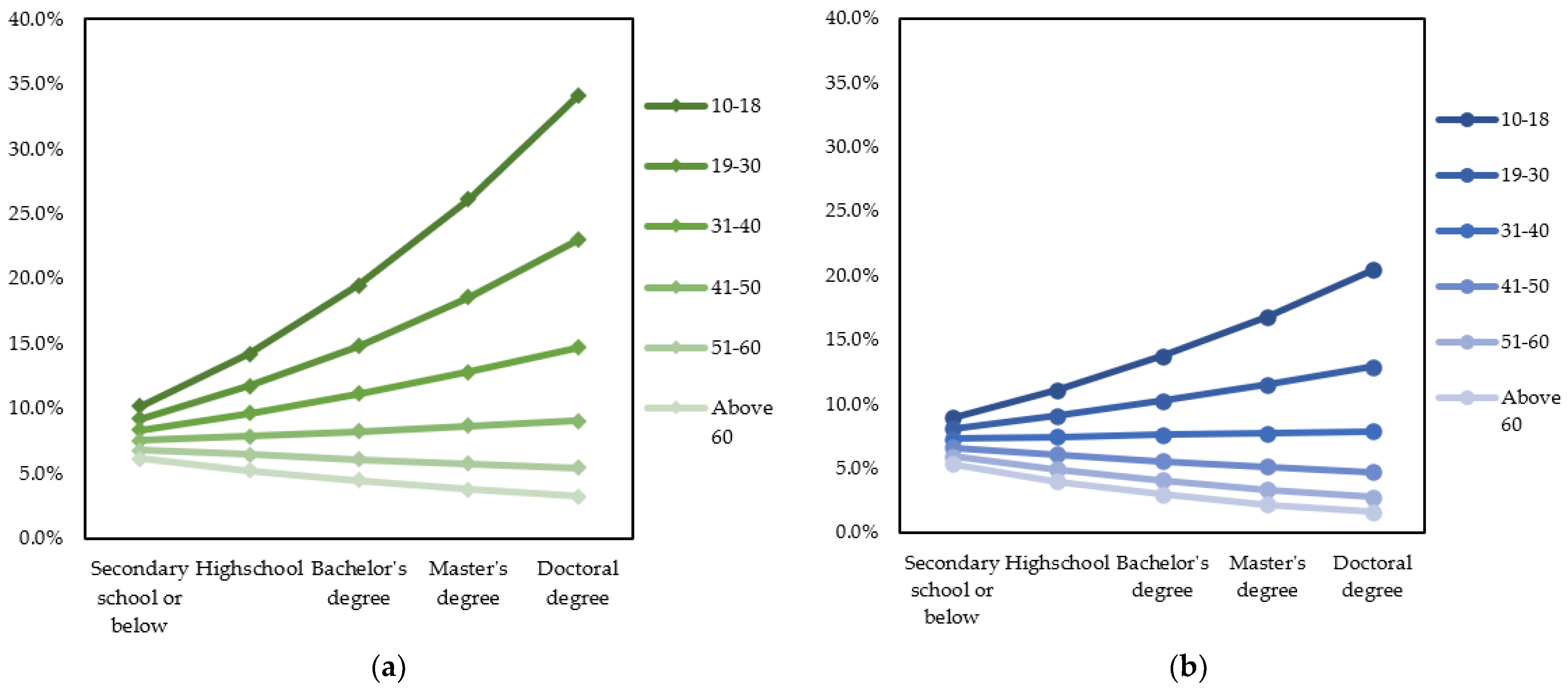
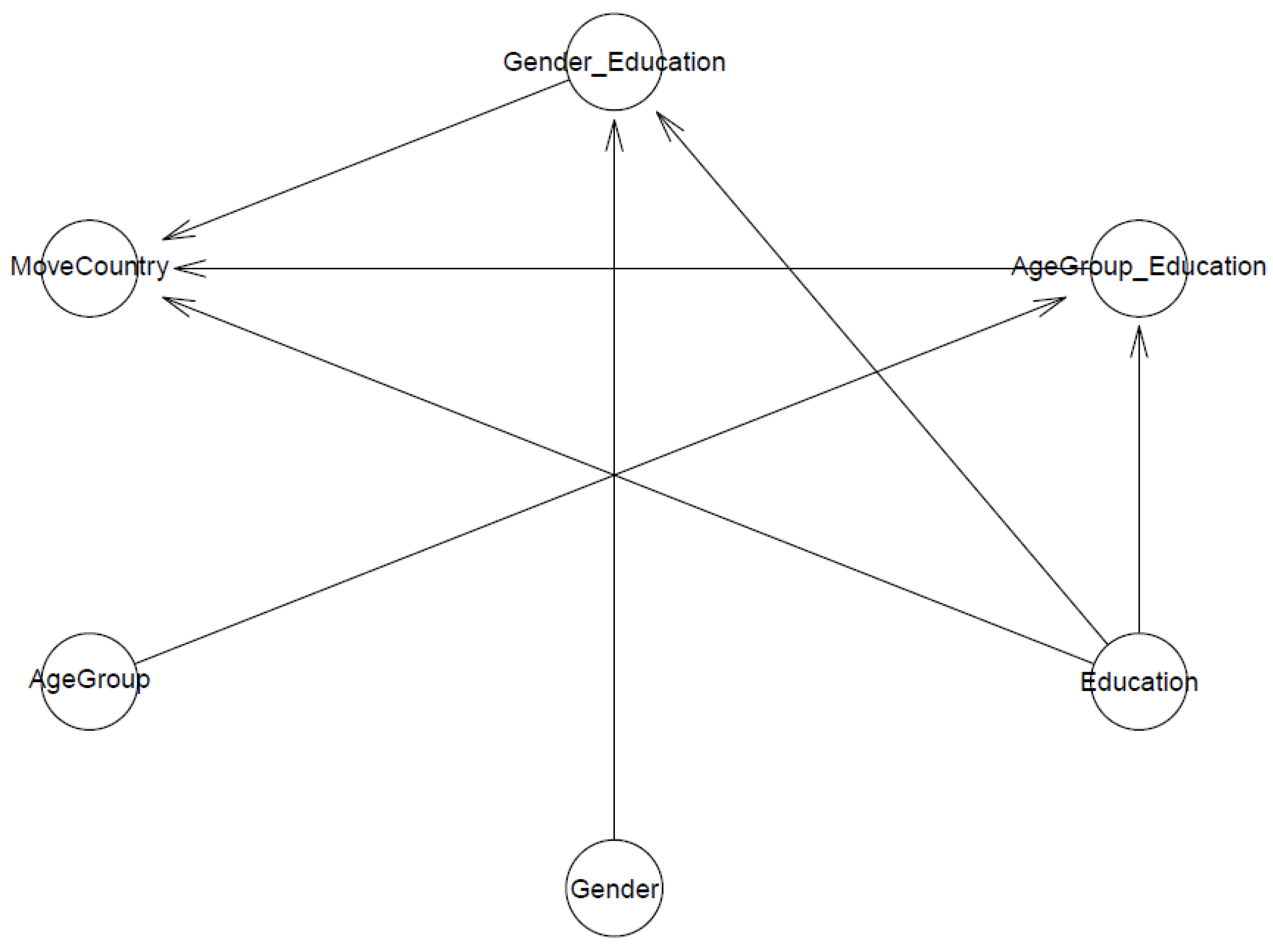
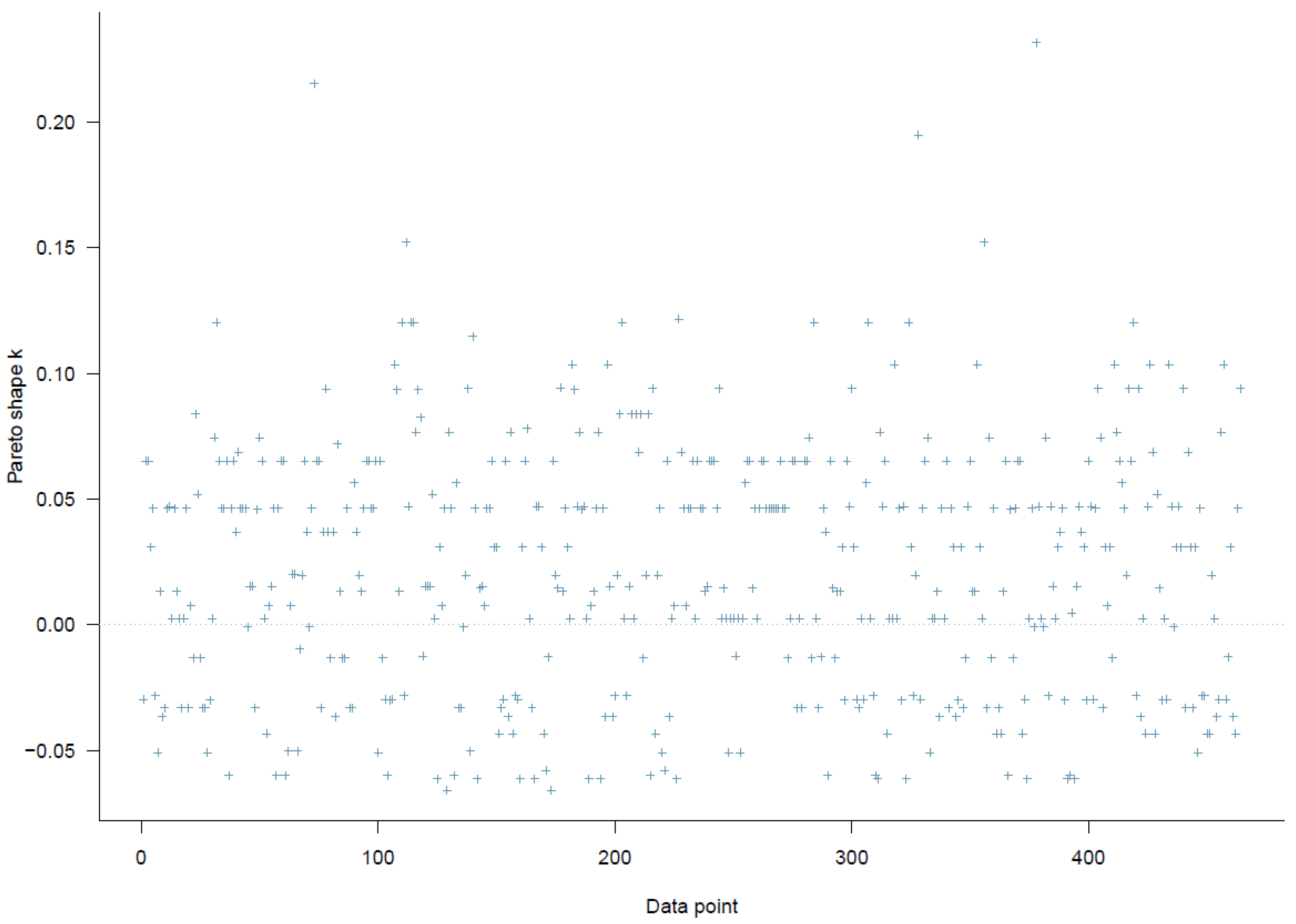
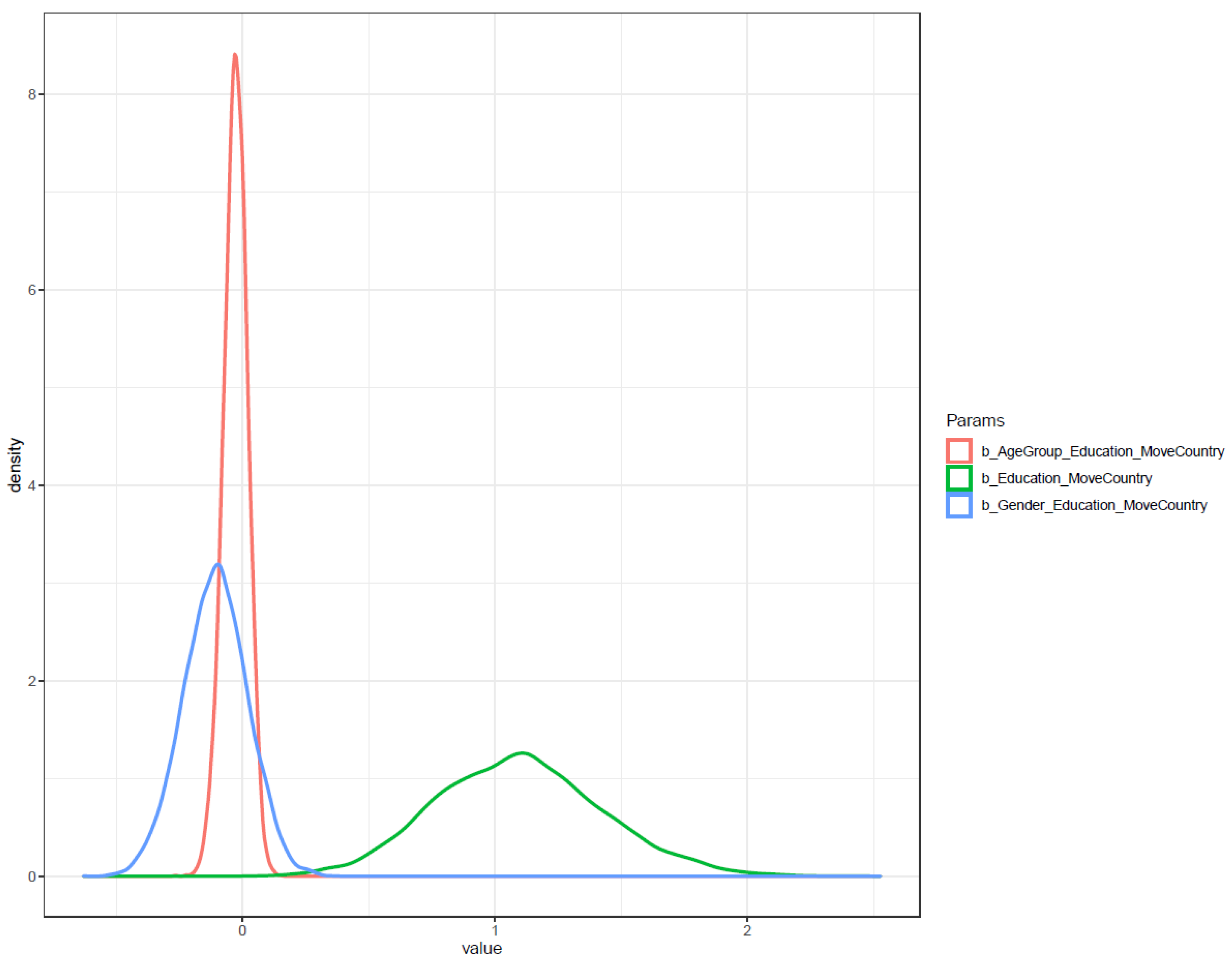
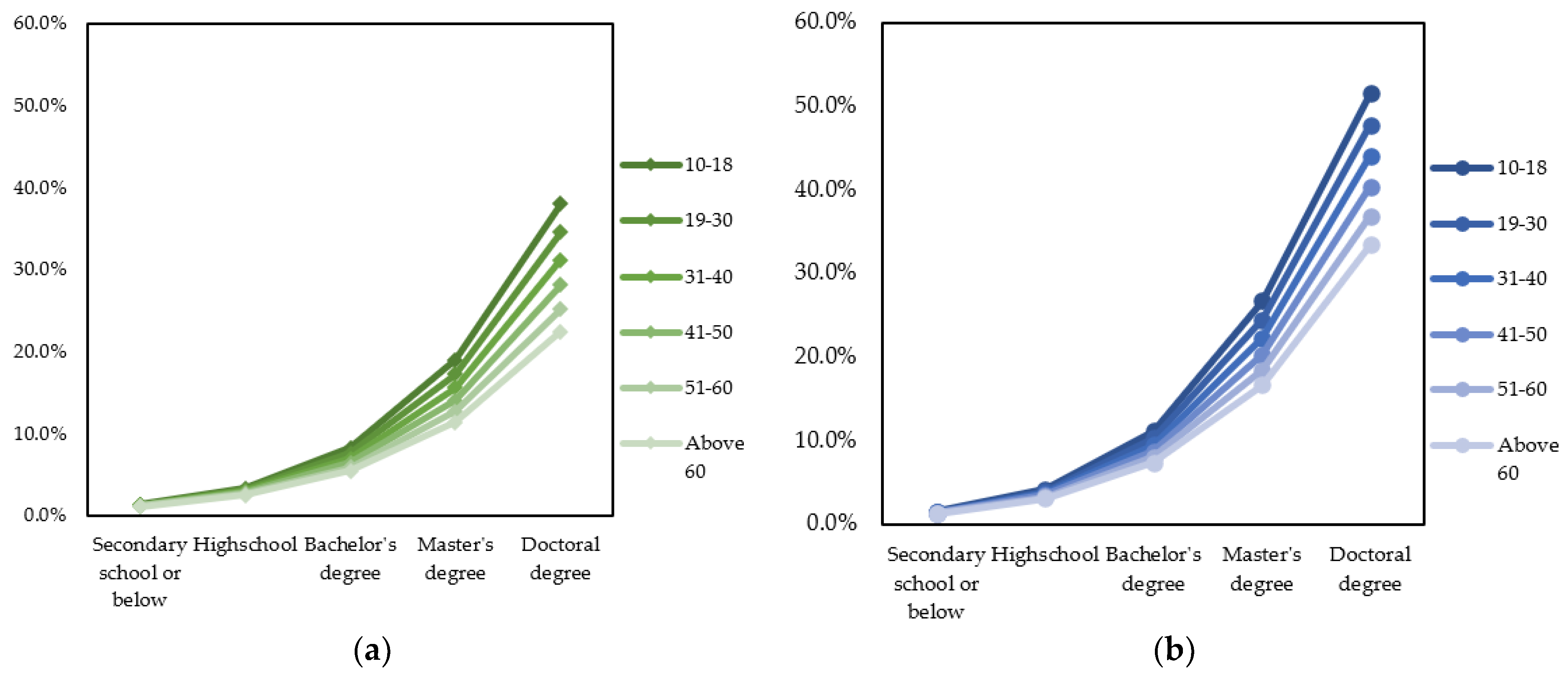
| Variable | Meaning | Type of Variable | Value |
|---|---|---|---|
| MoveCity | The intention of moving their family and work to a less polluted province due to the consideration of air pollution | Binary | Yes = 1 No = 0 |
| MoveCountry | The intention to move their family and work to a less polluted foreign country due to the consideration of air pollution | Binary | Yes = 1 No = 0 |
| Gender | Gender of the respondent | Binary | Male = 1 Female = 0 |
| Education | The highest achieved level of education of the respondent | Continuous | Secondary school or below = 1 Highschool = 2 Technical school/College degree and Bachelor’s degree = 3 Master’s degree = 4 Doctoral degree = 5 |
| AgeGroup | The age group that the respondent belongs to | Continuous | From 10 to 18 = 1 From 19 to 30 = 2 From 31 to 40 = 3 From 41 to 50 = 4 From 51 to 60 = 5 Above 60 = 6 |
| Parameters | Uninformative Priors | Belief in the Brain Drain N (1, 0.5) | Disbelief in the Brain Drain N (0, 0.5) | |||||||||
|---|---|---|---|---|---|---|---|---|---|---|---|---|
| Mean | Standard Deviation | n_eff | Rhat | Mean | Standard Deviation | n_eff | Rhat | Mean | Standard Deviation | n_eff | Rhat | |
| Constant | −2.56 | 0.64 | 5921 | 1 | −2.84 | 0.61 | 6992 | 1 | −2.43 | 0.59 | 6312 | 1 |
| Education | 0.35 | 0.25 | 5188 | 1 | 0.50 | 0.22 | 7131 | 1 | 0.28 | 0.23 | 6314 | 1 |
| AgeGroup_Education | −0.11 | 0.05 | 5837 | 1 | −0.12 | 0.05 | 8089 | 1 | −0.10 | 0.05 | 7235 | 1 |
| Gender_Education | 0.14 | 0.12 | 7214 | 1 | 0.11 | 0.12 | 8150 | 1 | 0.15 | 0.12 | 7512 | 1 |
| Parameters | Uninformative Priors | Belief in the Brain Drain N (1, 0.5) | Disbelief in the Brain Drain N (0, 0.5) | |||||||||
|---|---|---|---|---|---|---|---|---|---|---|---|---|
| Mean | Standard Deviation | n_eff | Rhat | Mean | Standard Deviation | n_eff | Rhat | Mean | Standard Deviation | n_eff | Rhat | |
| Constant | −5.29 | 0.91 | 5312 | 1 | −5.20 | 0.81 | 6027 | 1 | −4.51 | 0.75 | 6060 | 1 |
| Education | 1.10 | 0.33 | 5188 | 1 | 1.07 | 0.28 | 6051 | 1 | 0.77 | 0.26 | 5942 | 1 |
| AgeGroup_Education | −0.03 | 0.05 | 7837 | 1 | −0.03 | 0.05 | 7652 | 1 | −0.01 | 0.05 | 7652 | 1 |
| Gender_Education | −0.11 | 0.13 | 8214 | 1 | −0.10 | 0.13 | 8746 | 1 | −0.07 | 0.13 | 8154 | 1 |
Publisher’s Note: MDPI stays neutral with regard to jurisdictional claims in published maps and institutional affiliations. |
© 2022 by the authors. Licensee MDPI, Basel, Switzerland. This article is an open access article distributed under the terms and conditions of the Creative Commons Attribution (CC BY) license (https://creativecommons.org/licenses/by/4.0/).
Share and Cite
Khuc, Q.V.; Nguyen, M.-H.; Le, T.-T.; Nguyen, T.-L.; Nguyen, T.; Lich, H.K.; Vuong, Q.-H. Brain Drain out of the Blue: Pollution-Induced Migration in Vietnam. Int. J. Environ. Res. Public Health 2022, 19, 3645. https://doi.org/10.3390/ijerph19063645
Khuc QV, Nguyen M-H, Le T-T, Nguyen T-L, Nguyen T, Lich HK, Vuong Q-H. Brain Drain out of the Blue: Pollution-Induced Migration in Vietnam. International Journal of Environmental Research and Public Health. 2022; 19(6):3645. https://doi.org/10.3390/ijerph19063645
Chicago/Turabian StyleKhuc, Quy Van, Minh-Hoang Nguyen, Tam-Tri Le, Truc-Le Nguyen, Thuy Nguyen, Hoang Khac Lich, and Quan-Hoang Vuong. 2022. "Brain Drain out of the Blue: Pollution-Induced Migration in Vietnam" International Journal of Environmental Research and Public Health 19, no. 6: 3645. https://doi.org/10.3390/ijerph19063645
APA StyleKhuc, Q. V., Nguyen, M.-H., Le, T.-T., Nguyen, T.-L., Nguyen, T., Lich, H. K., & Vuong, Q.-H. (2022). Brain Drain out of the Blue: Pollution-Induced Migration in Vietnam. International Journal of Environmental Research and Public Health, 19(6), 3645. https://doi.org/10.3390/ijerph19063645








